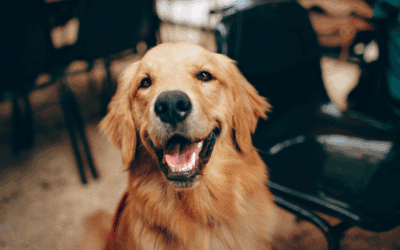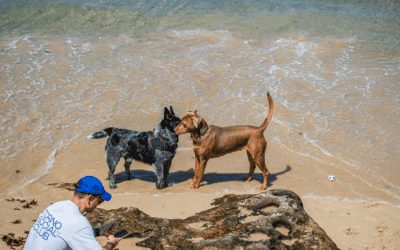Disclaimer: Kate’s K9 Pet Care proudly provides dog walking, cat sitting, small animal pet care, pet taxi services, “Almost Overnight” pet care, and convenient pet supply delivery.
For full details about each of our services, please visit our Service Pages to learn more about how we can support your pet’s needs. To see where we currently operate, please visit our Service Area Page.
Have you ever watched your dog twitch, whimper, or ‘run’ in their sleep and wondered ‘what do dogs dream about?’ The idea that dogs dream has fascinated dog owners and animal lovers for years. Our furry friends’ nocturnal adventures offer a glimpse into the mysterious world of canine cognition and behavior. In this blog post, we’ll explore the enchanting realm of dog dreams and uncover what might be running through their minds while the dogs spend most of their time in slumber.

Understanding the Stages of Dog Sleep
Dogs, like humans, experience multiple stages of sleep, each with distinct characteristics and functions. These stages include:
1. NREM (Non-Rapid Eye Movement) Sleep
NREM sleep is the initial phase where your sleeping dog may begin to drift off. It is the lighter stage of sleep and can be further broken down into three sub-stages:
Need Pet Care Fast?
Submit an Instant Service Request today and we’ll take care of the rest.
- Stage 1 (Light Sleep): This is the transition from wakefulness to sleep. During this stage, your dog’s body starts to relax, but they can easily be awakened and a good example of this is day sleeping.
- Stage 2 (Moderate Sleep): In this phase, brain activity slows down, and body temperature drops. Your dog’s heart rate and breathing also become more regular.
- Stage 3 (Deep Sleep): Also known as slow-wave sleep (SWS), this deeper stage is crucial for physical recovery. Cellular repair and growth take place, and the immune system is strengthened.
2. REM (Rapid Eye Movement) Sleep
REM sleep is characterized by rapid eye movements, increased brain activity, and vivid dreams. It is during this stage that most dreaming occurs:
- Dream Intensity: REM sleep in dogs is often associated with more vivid and complex dreams. You might observe their eyes moving under closed lids, muscle twitching, or vocalizations.
- Brain Function: Although their muscles remain relaxed to prevent acting out their dreams, the brain is highly active, similar to when they are awake. This stage is essential for cognitive functions and memory consolidation.
3. Wakefulness
Although not a stage of sleep, periods of wakefulness still play a role in a dog’s overall sleep pattern:
- Transitions: Dogs often experience brief periods of wakefulness between sleep cycles and may shift positions or briefly wake to survey their surroundings.
- Guarding Instinct: Even while resting, dogs’ evolutionary guarding instincts keep them semi-alert to potential threats, resulting in this brief arousal.
Understanding these stages can help you better appreciate the complexity of your dog’s sleep and the importance of ensuring they get adequate rest. Each stage plays a vital role in maintaining their physical health, emotional well-being, and cognitive function
Dogs, like humans, experience different stages of sleep. These stages include light sleep, deep sleep, and the REM (Rapid Eye Movement) sleep phase. During REM sleep, brain activity increases, and this is when dreaming occurs. While dogs and humans share similar sleep cycles, the time spent in each stage can differ significantly.
In humans, REM sleep accounts for about 20-25% of the sleep cycle. Dogs, on the other hand, spend roughly 10-12% of their sleep cycle in REM sleep. This difference means that dogs may have shorter but more frequent dreams compared to humans. Understanding these sleep patterns helps us appreciate the complexity of our canine companions’ slumber.
Just like humans, dogs exhibit unique behaviors during different sleep stages. For instance, in the REM sleep phase, you might notice your dog’s eyes moving rapidly beneath their closed lids, accompanied by twitching paws or subtle vocalizations. These signs suggest that your dog is indeed dreaming.

Signs That Your Dog Could Be Dreaming
Dogs exhibit various signs that indicate they are in the midst of a dream. Observing these behaviors can be fascinating and reveal much about their dream state:
1. Twitching and Muscle Movements
One of the most common signs that a dog is dreaming is twitching. You’ll often see their paws, legs, or facial muscles moving involuntarily. These small, repetitive movements are a clear indication that their brain is active during sleep.
2. Vocalizations
Dogs may make a range of sounds while dreaming, from soft whimpers to barks and even growls. These vocalizations correspond to the scenarios they are experiencing in their dreams and offer a peek into their dream world.
3. Rapid Eye Movements (REM)
During REM sleep, dogs experience rapid eye movements beneath their closed eyelids. This is a strong indicator of dreaming, as this stage is associated with intense brain activity and vivid dreams.
4. Breathing Patterns
A dog’s breathing may become irregular or varied during their dream state. You might notice faster and shallower breaths, or a slight increase in their heart rate, aligning with the excitement or activity level of their dreams.
5. Body Movements
In addition to smaller twitches, dogs may also make more significant body movements. This could include paddling their legs as if running, occasionally mimicking the actions they perform when awake.
6. Expressions and Facial Movements
Dogs might display different facial expressions while dreaming, such as twitching whiskers, moving their ears, or wrinkling their noses. These subtle changes in facial appearance can give clues to the scenarios playing out in their dreams.
Understanding these signs not only enhances our insight into the sleeping behavior of dogs but also strengthens the bond between pet and owner. Recognizing when your dog is dreaming helps to ensure they enjoy uninterrupted, restful sleep, contributing to their overall well-being.
What Dogs Dream About?
The content of dog dreams has been a subject of extensive research and speculation. While we can’t ask dogs directly about their dreams, studies suggest that their nightly visions might be influenced by their daily experiences and environment. Can A dog’s breed affect dreams? Yes, along with age, and even their recent activities can play a role in shaping their dreamscapes.
Research from Harvard Medical School and the Massachusetts Institute of Technology suggests that dogs, like human dreams, replay long sequences of their daily activities in their dreams. For example, a dog that spent the day chasing rabbits might dream of similar pursuits at night. This phenomenon is supported by observations of brain waves and electrical activity during REM sleep.
Interestingly, puppies and senior dogs tend to dream more frequently than adult dogs. Puppies, with their rapidly developing brains, and older dogs, with their accumulated experiences, both have rich dream lives. Smaller dogs also tend to have more frequent dreams compared to larger breeds, although the latter may have longer dreams.

The Importance of Dreaming for Dogs
Dreaming isn’t just a whimsical pastime for dogs; it plays a crucial role in their overall well-being. One of the primary functions of dreaming in dogs is memory consolidation. During sleep, especially REM sleep, the brain processes and organizes information gathered throughout the day. This helps dogs retain and learn new skills, making them more adaptable and responsive.
Quality sleep and dreaming also contribute to a dog’s emotional health. Well-rested dogs are generally happier and less prone to behavioral issues. Conversely, dogs that experience poor sleep or frequent nightmares may exhibit anxiety or aggression when awake. Ensuring your dog gets enough restful sleep is essential for their mental and emotional balance.
Furthermore, dreaming allows dogs to process their experiences and emotions. Just as humans might dream about resolving conflicts or facing fears, dogs may use their dreams to work through their feelings and reactions to daily events. This emotional processing can lead to a more content and well-adjusted pet.
Fun Facts and Anecdotes
The world of dog dreams is filled with fascinating tidbits and heartwarming stories. Did you know that some dogs dream about their favorite activities, like chasing balls or playing with other dogs? Owners have reported seeing their pets “run” in their sleep, complete with paw movements and joyful barks.
In one particularly charming anecdote, a dog owner shared how their dog, who loved to dig in the backyard, would often “dig” in their sleep. The dog’s legs would move rhythmically, mimicking the action of digging a hole. Such behaviors provide a delightful insight into the dreams of our canine companions.
Dogs can also have nightmares, just like humans. If your dog suddenly wakes up from sleep, appearing distressed or anxious, they might have experienced a bad dream. Comforting them and ensuring they feel safe can help alleviate any lingering anxiety.

When to Worry About Your Dog Dreaming
While dreaming is a natural and healthy part of a dog’s sleep cycle, there are times when certain behaviors may be cause for concern. Knowing what is normal and what warrants a visit to the vet can help ensure the health and well-being of your furry companion.
1. Excessive or Violent Movements
Occasional dog twitching and minor body movements are common during dreams, but if your dog exhibits excessive or violent thrashing, it could indicate a problem. Repeated intense movements may suggest a neurological issue or a sleep disorder, and should be evaluated by a veterinarian.
2. Prolonged Distress Signs
While some vocalizations are normal, continuous whimpering, yelping, or growling for prolonged periods can be a sign that something is wrong. If your dog seems to be in visible distress during sleep on a regular basis, it may be experiencing anxiety or pain. Consulting with a vet can help determine the underlying cause.
3. Difficulty Waking Up
Typically, dogs will wake up easily from sleep, especially during the lighter stages. If your dog is unusually difficult to rouse or seems disoriented and uncoordinated upon waking, it could indicate an underlying medical condition such as a seizure disorder.
4. Abnormal Breathing Patterns
While varied breathing patterns can be a normal part of dreaming, consistently irregular or labored breathing should not be overlooked. Persistent changes in breathing during sleep might be indicative of respiratory issues or other health concerns that require medical attention.
5. Changes in Sleep Routine
Sudden changes in your dog’s sleep patterns, such as increased or decreased sleep duration, restlessness, or frequent awakenings, could point to health problems. Any deviation from their usual sleep routine should be monitored and discussed with a vet to rule out potential issues.
6. Signs of Pain or Discomfort
If your dog shows signs of pain or discomfort, such as limping, whining, or avoiding certain activities, and these continue into their sleep behavior, it may be time for a check-up. Pain and discomfort can disrupt normal sleep and dreaming patterns, negatively impacting their overall health.
By paying attention to these warning signs, you can help ensure that your dog’s dream experiences remain a healthy and enriching part of their life. Regular veterinary check-ups and being observant of any changes in behavior can aid in early detection and treatment of potential health issues, making sure your dog enjoys safe and pleasant dreams.

Conclusion | What Do Dogs Dream About?
Kate’s K9 Pet Care Services is here to support you with a wide range of pet care services for your pup. Contact us today!
Dog dreams offer a captivating glimpse into the minds of our beloved pets. From the twitching paws of a dreaming puppy to the determined “running” of an older dog, these nightly adventures reveal just how complex and rich the inner lives of dogs can be. Understanding what dogs dream about and the importance of these dreams can deepen our bond with them and enhance their well-being.
We encourage you to observe your own dog’s dream behaviors and share your experiences with us. Let’s celebrate the enchanting world of dog dreams together! For more engaging content on dog behavior and care, subscribe to our newsletter and never miss an update.







